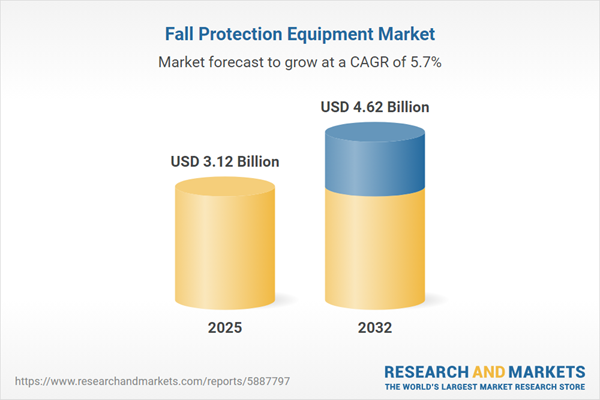Speak directly to the analyst to clarify any post sales queries you may have.
The fall protection equipment market is evolving rapidly as organizations worldwide prioritize worker safety and compliance. With new technologies and stricter regulations, senior decision-makers face increasingly complex purchase and operational landscapes.
Market Snapshot: Fall Protection Equipment Market
The global fall protection equipment market grew from USD 2.96 billion in 2024 to USD 3.12 billion in 2025 and is projected to reach USD 4.62 billion by 2032, expanding at a CAGR of 5.73%. Adoption is driven by safety mandates, industrial growth, and innovation in personal protective technologies. Key sectors anchoring demand include construction, utilities, oil and gas, and telecommunications, with different regions exhibiting unique regulatory and operational requirements.
Scope & Segmentation
This report delivers a comprehensive analysis of the fall protection equipment market, covering technology trends, regional regulations, and evolving stakeholder strategies. Segment insights ensure strategic planning across industries and applications.
- Product Types: Access systems, anchor points, carabiners, harnesses, lanyards, safety nets, and self-retracting lifelines.
- Mechanisms: Active and passive systems.
- Material Types: Aluminum, nylon, polyester, and stainless steel.
- Applications: Adventure sports, height work safety, rescue operations.
- End Users: Construction, energy & utilities, manufacturing, mining, oil & gas, telecommunications, transportation.
- Distribution Channels: Department stores, specialist stores, brand websites, and eCommerce platforms.
- Regions: Americas (North America: United States, Canada, Mexico; Latin America: Brazil, Argentina, Chile, Colombia, Peru), Europe, Middle East & Africa (Europe: United Kingdom, Germany, France, Russia, Italy, Spain, Netherlands, Sweden, Poland, Switzerland; Middle East: United Arab Emirates, Saudi Arabia, Qatar, Turkey, Israel; Africa: South Africa, Nigeria, Egypt, Kenya), Asia-Pacific (China, India, Japan, Australia, South Korea, Indonesia, Thailand, Malaysia, Singapore, Taiwan).
- Key Companies: Major players include 3M Company, ABS Safety GmbH, ACE Handels- und Entwicklungs GmbH, Bergman & Beving AB, Blue Eagle Safety, Carl Stahl Holding GmbH, CERTEX Hebetechnik GmbH, COFRA S.r.l., County Safety Services Ltd., Delta Plus Group, Elk River, Inc., Eurosafe Solutions Ltd., FallTech, French Creek Production, Guardian Fall by Pure Safety Group, Inc, Hailo-Werk Rudolf Loh GmbH & Co. KG, Honeywell International Inc., Irudek, Karam Safety Private Limited, Karmor Co., Limited, Kee Safety Inc., Klein Tools, Inc., MSA Safety Incorporated, Petzl, PFEIFER Holding GmbH & Co. KG, Protective Industrial Products, Safe Approach Inc., Super Anchor Safety, T. I. Trading Co., Ltd, Udyogi Safety Company, WernerCo.
Key Takeaways for Decision-Makers
- Advanced fall protection systems are essential for mitigating operational risks and supporting regulatory compliance in high-risk sectors.
- The integration of smart sensors and predictive analytics is transforming both equipment efficiency and safety oversight, promoting proactive risk management.
- Material innovations enhance durability and comfort, encouraging adoption across a broader user base without sacrificing protection or compliance.
- Procurement strategies are increasingly shaped by regional regulatory frameworks, driving demand for certified and modular solutions.
- Adoption of direct-to-customer digital platforms enables tailored product access, service delivery, and data collection for continuous improvement.
- Providers investing in regional assembly and strategic partnerships are better equipped to respond to evolving supply challenges and market requirements.
Tariff Impact on Supply Chains
Recent tariff adjustments, particularly within the United States, have created significant cost disparities between domestic and imported fall protection components. As manufacturers adjust, lead times have lengthened and the need for strategic sourcing—including local partnerships and hybrid procurement models—has increased. These changes have particularly impacted mid-sized organizations seeking cost-effective and timely product access.
Methodology & Data Sources
This report combines primary interviews with safety managers, procurement specialists, and regulatory consultants, with secondary research from industry publications and regulatory filings. Laboratory testing on product durability and safety is included, as well as supply chain analysis and patent intelligence, reviewed by third-party safety certification experts to support actionable insights.
Why This Report Matters
- Empowers decision-makers to adjust operations and procurement for regulatory, technological, and tariff-driven changes.
- Identifies leading players and regional nuances crucial for tailored go-to-market strategies and risk assessment.
- Equips organizations with practical guidelines for adopting integrated safety platforms and responding to evolving compliance demands.
Conclusion
Insightful analysis of the fall protection equipment market enables leaders to act decisively in a fast-developing landscape. Proactive adaptation positions organizations to better protect their workforce and maintain operational continuity across changing safety and trade environments.
Additional Product Information:
- Purchase of this report includes 1 year online access with quarterly updates.
- This report can be updated on request. Please contact our Customer Experience team using the Ask a Question widget on our website.
Table of Contents
3. Executive Summary
4. Market Overview
7. Cumulative Impact of Artificial Intelligence 2025
Companies Mentioned
The companies profiled in this Fall Protection Equipment market report include:- 3M Company
- ABS Safety GmbH
- ACE Handels- und Entwicklungs GmbH
- Bergman & Beving AB
- Blue Eagle Safety
- Carl Stahl Holding GmbH
- CERTEX Hebetechnik GmbH
- COFRA S.r.l.
- County Safety Services Ltd.
- Delta Plus Group
- Elk River, Inc.
- Eurosafe Solutions Ltd.
- FallTech
- French Creek Production
- Guardian Fall by Pure Safety Group, Inc
- Hailo-Werk Rudolf Loh GmbH & Co. KG
- Honeywell International Inc.
- Irudek
- Karam Safety Private Limited
- Karmor Co., Limited
- Kee Safety Inc.
- Klein Tools, Inc.
- MSA Safety Incorporated
- Petzl
- PFEIFER Holding GmbH & Co. KG
- Protective Industrial Products
- Safe Approach Inc.
- Super Anchor Safety
- T. I. Trading Co., Ltd
- Udyogi Safety Company
- WernerCo.
Table Information
| Report Attribute | Details |
|---|---|
| No. of Pages | 190 |
| Published | November 2025 |
| Forecast Period | 2025 - 2032 |
| Estimated Market Value ( USD | $ 3.12 Billion |
| Forecasted Market Value ( USD | $ 4.62 Billion |
| Compound Annual Growth Rate | 5.7% |
| Regions Covered | Global |
| No. of Companies Mentioned | 32 |









